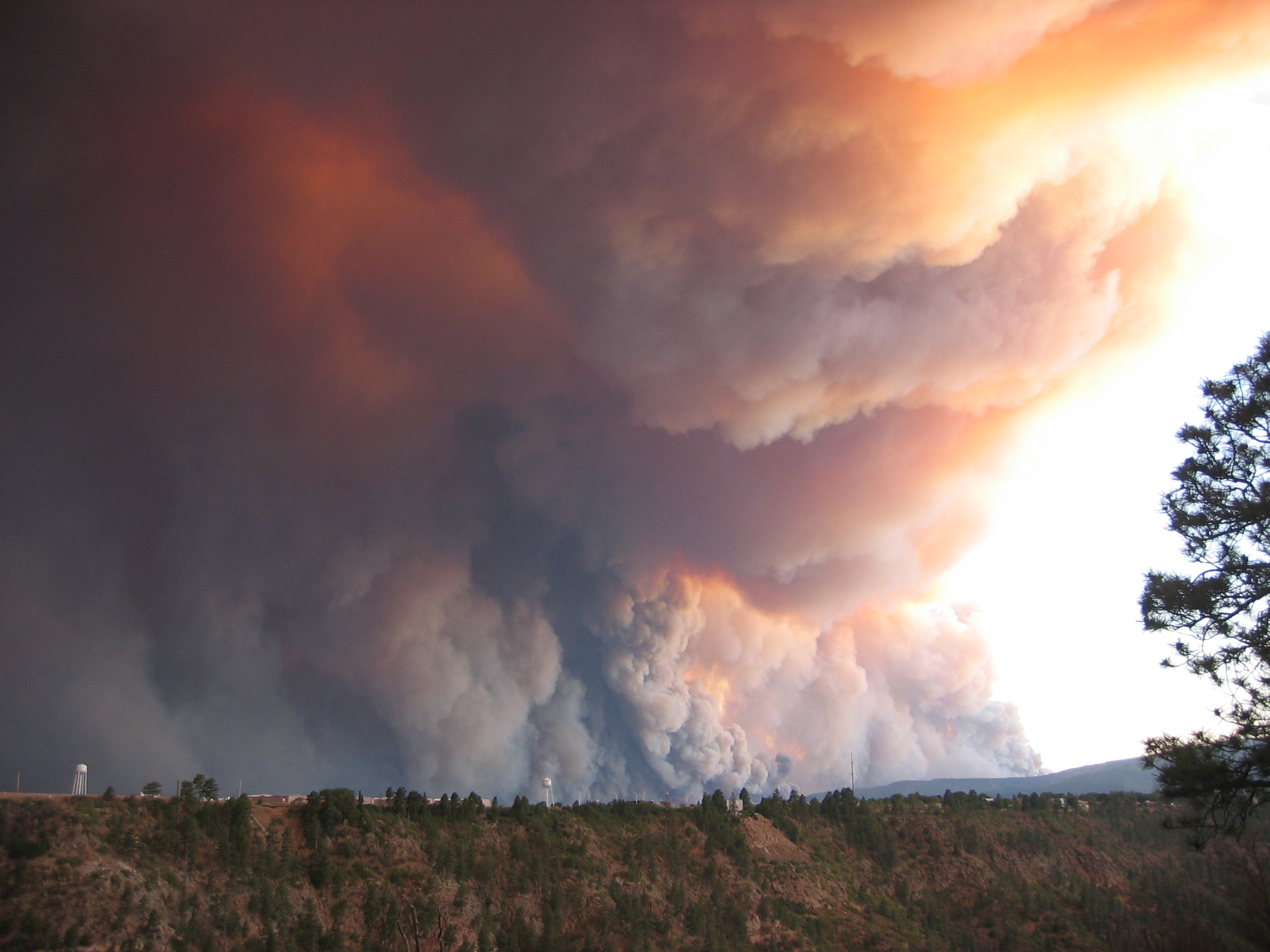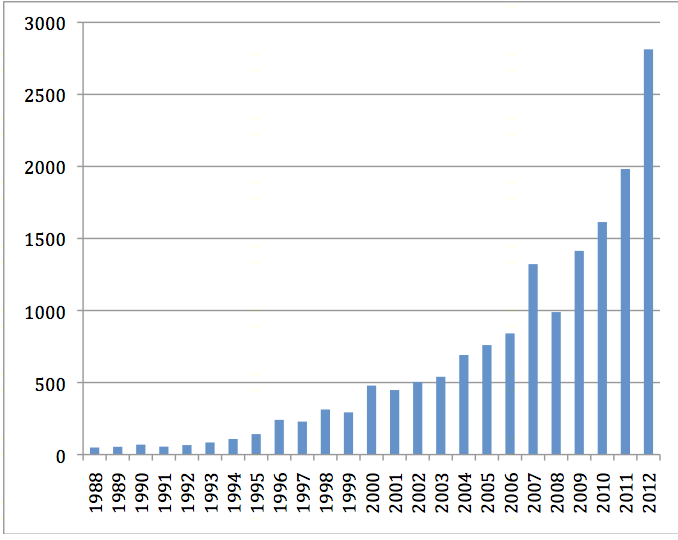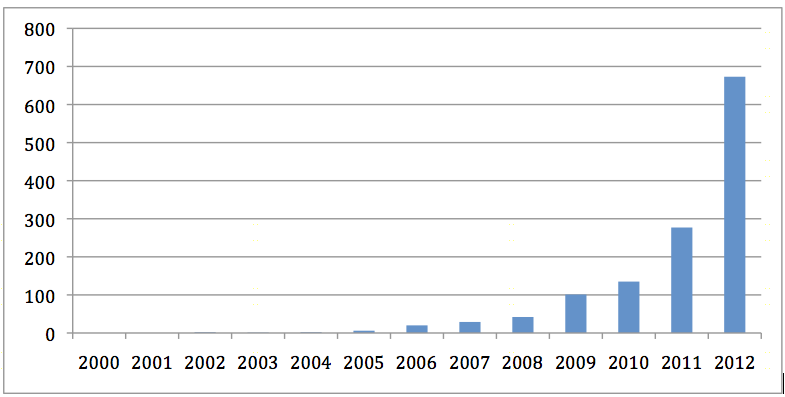
January 30, 2013, by Brigitte Nerlich
Extreme weather events, climate change and the media
I am not a scientist. I am a media analyst of sorts. I therefore cannot check the veracity of scientific statements that establish a link between climate change and an increase in frequency of extreme weather events or scientific statements that dispute such a link. I also find it difficult to assess what climate is, or should be, regarded as normal, by whom and on what basis. What I can do is observe the way that an issue or problem is discussed in the public sphere, taking press coverage as a proxy (and, I know, a rather bad one, but one that’s available for research) – and extreme weather as ‘the new normal’ in the context of climate change is an issue of public debate that I’ll try to tackle today.
Extreme weather and climate change
The link between climate change and extreme weather is generally hedged with caveats, as the process of unpicking signal from noise in weather data is extremely difficult. While the topic remains the subject of much debate, some scientists are beginning to make that link, it has come to permeate public perception and it is increasingly discussed in media coverage.
In the past, images of (relatively rare and sensational) extreme weather events, such floods, droughts, heat waves, storms and so on, were used to convince people of the reality of and threats posed by climate, and, of course to sell newspapers. Such images were, to some extent, more symbolic than real, such as the flooding of Cologne cathedral on the front page of Der Spiegel in 1986 This fictional image was a symbol of the perceived dangers of future climate change, or as people called it in Germany, the impending Klimakatastrophe. Now this same image has, for some, become a symbol of climate alarmism or catastrophism.
Extreme weather in the media
However, in recent years, media reports of extreme weather events and disasters, which of course include dramatic images, have become more frequent and almost commonplace in media reporting from around the world. (The graph below shows reporting on ‘extreme weather’ in Major English speaking newspapers, from 1988 onwards, when climate change became a political issue).
There can be many reasons for this rise: an increase in extreme weather events, an increase in general media production, a media bandwagon effect, the ease with which images of extreme weather events and disasters can now be captured and disseminated online and be used to illustrate articles. Be this as it may, this increase in extreme weather talk in the media could lead to a situation where reports on and images of extreme weather are no longer seen as mere symbols of future climate change but instead as documentary evidence for its arrival here and now. This trend can be seen as a good thing or a bad thing…
A new phrase has emerged that makes the link between extreme weather events and climate change in a rather forceful way: extreme weather or weather related disasters, such as Hurricane Sandy or the Australian heat wave for example, are said to be ‘the new normal’.
The new normal
When you ask a famous search engine ‘who coined the phrase the new normal?’ the results you get seem to indicate that the phrase was first used by economists to describe the aftermath of the recession. (The phrase also occurs in the context of a television series about stay-at-home-parenting, ‘The New Normal‘)
However, when digging a bit deeper one finds that the phrase is older than 2008. It was for example used in 2002 in the context of discussing a drought in Texas, and I would guess there are earlier attestations that I have not found yet. In the following paragraph the phrase is used for the first time in ‘All English language news’ in the context of climate change (I used the key words ‘new normal’ and ‘climate change’ to search Nexis®) (I have left out paragraph breaks): “Cattle are standing in bone-dry meadows of brown grass. The creeks are running low. Two scrawny deer run across the road. And I wonder if these are the good old days. What if we tell our grandchildren about a time when Colorado had forests, mountains covered with snow, rivers full of fish, enough water to irrigate even the worthless grass along hundreds of miles of highways – and they think we’re demented? What if this drought of ’02 is the new normal? ‘It’s very hard to say what the cause of any drought is,’ said Brian Toon, director of the Atmospheric and Oceanic Sciences program at the University of Colorado-Boulder, when I ask him if this desperately dry year is normal. He said it’s possible that it’s simply the cyclical nature of the weather.” This sounds very much like the coverage of the more recent drought in Texas.
Two years later in 2004 the phrase appeared for the first time in the headline of an article dealing with disaster management. Since then the phrase has steadily grown in popularity in the media (see right), with a peak around the end of 2012 and the beginning of 2013. This peak seems to be associated with describing extreme weather events like Hurricane Sandy as the new normal (there are 440,000 attestations of ‘Hurricane Sandy’ and ‘new normal’ on Google, compared to 20,500 results for ‘Texas drought’ and ‘new normal’, for example; as of 29 January, 2013).
What may be the reasons for the rise in popularity of this new phrase? There are at least two competing explanations. One is that the earth’s climate has now reached a new ‘normal’ state that causes an increase in extreme weather events, where extreme weather has become the norm. Or, ‘the new normal’ phrase is a rhetorical strategy adopted by those who have realised that alarmism doesn’t work when trying to persuade people of the reality of climate change. So instead of framing climate change as a catastrophe, it is framed as ‘the new normal’. This would mean that ‘the new normal’ is either a new alarmism (as some may argue) or it is a signal for a new climate realism/reality. Rather than discussing future predictions, which people may be inherently sceptical of in any walk of life, the ‘new normal’ recasts climate change as something happening right now, and not treated as a hypothetical.
All this is, of course, extremely contested ground, with some, like Climate Depot, arguing that ‘Extreme weather events are ever present, and there is no evidence of systematic increases’, while others argue that, according to New Scientist: “Scientists have warned for years that extreme weather would become more common, and now it is. What’s more, although single events can rarely be confidently attributed to climate change, clusters probably can.” And “The spate of extreme weather, then, is a snapshot of the not-too-distant future. Soon, this will be the new normal. We call events like the Australian heatwave ‘extreme weather’, but within the next few decades they will simply be ‘weather’.”
Whatever the reality or rhetoric behind ‘the new normal’, this phrase is part of a new conceptual landscape on which positions around climate change are mapped out and fought over. It is indicative of a new conceptual normal that has emerged in climate change discourse.
Image: Photo of Las Conchas wildfire in New Mexico



The Wikipedia entry for the “Committee for a Constructive Tomorrow” (who wrote the Climate Depot report) does not suggest to me that they are an unbiased, objective organisation. What do you think?
http://en.wikipedia.org/wiki/Committee_for_a_Constructive_Tomorrow
I just wanted to provide two illustrative quotes on a spectrum of responses to the extreme weather/climate change issue
I’m not sure that the New Scientist article gives any actual evidence for increased levels of extreme levels. Have I missed something?
It seems to me that the way to decide whether there is an increase in extreme weather is to :
a) define what an extreme weather event is
b) count how many there have been in previous years
An example of this is the work of Richard Wild at the University of Derby
http://www.derby.ac.uk/research/projects/monitoring-snowfall-trends/
Thanks for that link, that was very useful!
[…] shifts in public attention to climate change. Other posts have dealt with some first reflections on extreme weather, Hurricane Sandy, alarmism, carbon and energy discourses, and mitigation and […]
[…] Extreme weather events – 2013/01/30 […]
Extreme weather events aren’t just being reported more – they are happening more as is reported in this WMO report:
http://www.wmo.int/pages/prog/drr/transfer/2014.06.12-WMO1123_Atlas_120614.pdf
Also analysis by the re insurer MunichRE have shown an increase in extreme weather events –
http://icons.wxug.com/hurricane/2012/number_of_disasters.png
Also check out this analysis by NASA scientists which shows the shift in the distribution in summer temperatures in the Northern hemisphere.
The shift in this bell curve (a normal distribution) to the right compared to the 1950’s is what scientists are referring to when they speak of this being a ‘new normal’. Although there’s only been a small shift in the mean there’s been a large shift in the extremes. The authors of the study showed that hot extremes, which covered much less than 1% of Earth’s surface during the base period (1950-1980), now typically covers about 10% of the land area!
https://www.youtube.com/watch?v=yGJNqCfCI1U
It’s not alarmism. It’s quantifiable, verifiable fact!
I totally agree. Thanks for this information!